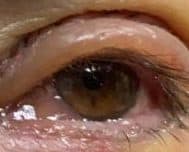We’ve all been there – facing the unpredictable weather or diving into a pool, relying on our waterproof mascara and eye makeup to emerge unscathed. It feels like a beauty dream come true, right? Well, hold on a sec. Dr. Stephanie Mulick, OD, a seasoned Optometrist, is urging all the beauty enthusiasts out there to consider the not-so-pretty consequences of long-term waterproof makeup use.
Dive into the Downside: The Long-Term Effects
A startling image from the American Academy of Ophthalmology reveals the dark side of waterproof makeup. It can become a permanent resident in the underside of your eyelid, leading to constant eye pain and irritation. So, before you swear by that waterproof mascara, consider the importance of proper makeup removal and maybe opt for non-waterproof alternatives that dissolve in the tear film.
Behind the Warnings: Dr. Mulick’s Insights
Dr. Mulick takes us on a journey into the intricate world of our eyelids. Did you know we have around 50 glands in our upper eyelids and 30 in our lower ones? These glands, responsible for secreting the oily lipid layer of our tear film, play a vital role in keeping our eyes healthy. However, waterproof makeup can throw a spanner in the works. Picture this: makeup particles getting stuck in these glands, turning into hard clumps instead of the necessary oily substance. This, my friends, can lead to dry eye syndrome, styes, red eyes, allergic conjunctivitis, blepharitis, meibomian gland dysfunction, and even blurred vision.
The Unseen Culprit: How Waterproof Makeup Behaves
The image above (photo credits: Premium Vision) depicts the impact of thickened oil trapped in the meibomian glands due to various factors, including the use of waterproof makeup. When these makeup particles clog the glands, they can lead to various eye conditions such as dry eye syndrome, styes, red eyes, allergic conjunctivitis, blepharitis, and meibomian gland dysfunction, potentially causing blurred vision and discomfort.
Waterproof makeup doesn’t play nice with the moisture in our eyes. Those tiny makeup particles don’t break down with the eye’s natural moisture, causing symptoms like eye irritation, a constant feeling of something in your eye, redness, inflammation, and, you guessed it, blurred vision.
This can contribute to the following eye conditions:
- Dry eye syndrome (click here to learn more about dry eye triggers and treatments)
- Styes (click here to read more about styes)
- Red eyes (click here to learn about red-eye triggers and remedies)
- Allergic conjunctivitis (click here to learn about allergic conjunctivitis and treatment options)
- Blepharitis (click here to learn about blepharitis and treatment options)
- Meibomian gland dysfunction (click here to read about Meibomian Gland Dysfunction)
- Blurred vision

Common Symptoms of waterproof makeup embedded in the eyelids:
- eye irritation
- the sensation of something in the eyes
- redness
- blurred vision
- inflammation of the eye and eyelid
Glamming Up Safely: Dr. Mulick’s Tips
But fear not, makeup lovers! Dr. Mulick suggests considering mineral-based makeup for a safer glam session. And here’s a pro-tip: avoid putting eyeliner on the “waterline” of your eye. Think of it as maintaining the cleanliness of your car’s windshield wipers and misters – critical for keeping your vision clear.
Waterline is not a medical term, but is a term widely used in the beauty industry to describe the part of the eyelid that is between the eyeball and the eyelashes.
This is the area of the eyelids where are meibomian glands open up to produce moisture for our eyes. If this area of the eye is covered in makeup then tear production is blocked.
Think about your windshield wipers and misters of your car. If someone slathered makeup on your windshield wipers and misters, they would not work very well and the windshield would look awful.
The “waterline” is basically like the windshield wipers and misters of your car. You want to keep them clean so that they can work properly.
This part of our eyelid is critical for keeping our eyes clean, our vision clear, and our eyes healthy.
Not only will the natural day-to-day tear production be affected, but the makeup will cover the surface of the eye causing a decrease in vision and disruption to the natural antibacterial properties of the tear layer that keeps our eyes moist.
Taking It Off Right: Safe Makeup Removal Techniques
Removing makeup becomes an art when you know the right techniques. Invest in eyelid cleansing products like Ivizia Eyelid wipes.
Hot compresses work wonders too, melting away any trapped oils in the meibomian gland canal. Dr. Mulick recommends at least 10-15 minutes of hot compress therapy, whether you use over-the-counter options or get creative with microwavable masks.
(click here for Dr Mulicks hot compress recommendations).
I’ve even heard of patients using hot potatoes or hard-boiled eggs (just don’t eat them afterward).
Beauty Ingredients to Beware Of
- BAK (benzalkonium chloride)
- Parabens
- Cinnamates
- Wax
- EDTA
- -urea (a formaldehyde-donating preservative)
- Sodium hydroxymethyglycinate
- Bonopol
- Glyoxyl
- Prostaglandin analogs (look for the suffix -prost)
Be your own beauty detective and watch out for ingredients like BAK, parabens, cinnamates, wax, and more. These eye irritants can be found in many cosmetic products, even the seemingly harmless “natural” or “organic” ones. Dr. Mulick advises steering clear of these culprits and opting for preservative-free alternatives.
The FDA is very lenient on the cosmetic industry, in the US only 11 cosmetic chemicals are banned, whereas in Europe 1,300 cosmetic chemicals are banned.
In the US cosmetic manufacturers only have to list 1% of the ingredients included in the cosmetic product.
Removing eye makeup daily is important to maintaining healthy eyes. Unfortunately, many eye makeup removers can also be filled with the same irritating chemicals.
One of the biggest culprits is BAK (benzalkonium chloride) a preservative that many people are sensitive to, and know for causing corneal irritation.
Although BAK is found in many OTC eye drops, the concentrations in cosmetics are much higher than those found in eye drops. To avoid BAK in eye drops it is recommended to use the preservative-free versions.
Other preservatives commonly found in cosmetics are parabens, a xenoestrogen believed to disrupt hormone function and known to cause Meibomian gland dysfunction and dry eyes.
(For more information on Meibomian gland dysfunction please review this link).
Even mineral-based products, or those that say, “natural” or “organic” can still be irritating to the eyes.
Cinnamates are commonly found in more natural products but may be a cause of inflammation of the eyelids.
Wax is typically found in waterproof makeup to make it stay on. As you can imagine applying wax to your eyelids is going to severely block the meibomian glands on the eyelids as discussed previously in this article.
Beyond Mascara: Other Beauty Products to Watch Out For
- Eyelash growth serum: can cause redness, inflammation, and darkening of the pigment on the eyelids and the eye itself.
- Permanent makeup: This seems like a good alternative, but has been shown to cause a decrease in function of the meibomian glands.
- False lashes: the glue can cover the meibomian glands leading to infection and redness. Magnetic lashes could be better but could cause breakage of eyelashes.
Dr. Mulick isn’t just sounding the alarm on mascara. Eyelash growth serums, permanent makeup, and false lashes can also play tricks on your eyes. So, before you dive into that beauty trend, consider the potential for redness, inflammation, and other complications.
While discontinuing eye makeup isn’t necessary, it’s essential to make informed, healthy decisions about the products you use.
The Final Look: Conclusion
Let’s face it; giving up eye makeup entirely might not be on the agenda. But being educated about the potential risks and making healthier choices? Now, that’s a beauty regimen we can all get behind. Research points to the fact that excessive use of waterproof mascara may increase the risk of eye infections, irritation, and redness. Dr. Mulick’s advice? Opt for mineral-based makeup alternatives to keep those peepers healthy and bright. Because, after all, beauty should enhance, not compromise.


73lytf
v4v8cm
ie653g